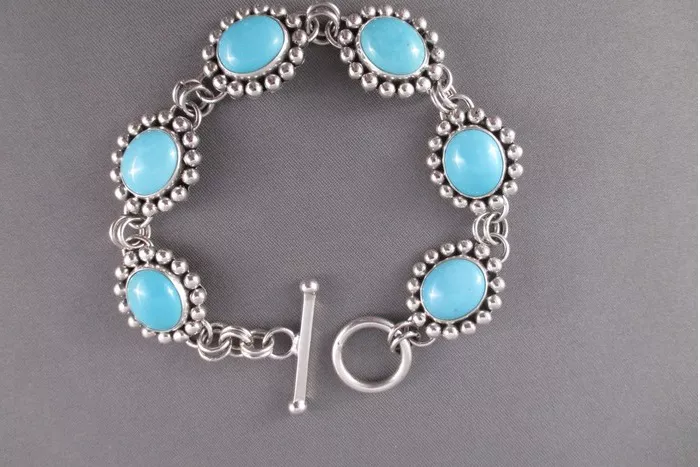In the realm of precious stones, turquoise stands out with its captivating hues and cultural significance. Among the world’s turquoise varieties, the turquoise from Hubei province in China holds a special place. Renowned for its unique colors and historical legacy, Hubei turquoise has captivated the attention of gemstone enthusiasts and collectors alike.
A Gemstone of Distinction
Hubei turquoise is celebrated for its distinct shades of blue and green, ranging from sky blue to deep green, often adorned with intricate veins and matrix patterns. This striking color palette is a result of its mineral composition, primarily consisting of hydrated copper aluminum phosphate. The presence of other minerals, such as iron, manganese, and zinc, contributes to the stone’s unique color variations.
One of the defining characteristics of Hubei turquoise is its captivating matrix patterns. These intricate veins and web-like formations, known as “spiderwebbing,” add depth and character to the gemstone, making each piece truly unique. The matrix patterns, formed by the presence of host rock minerals, enhance the aesthetic appeal of Hubei turquoise, distinguishing it from other turquoise varieties.
A Rich Cultural Heritage
The history of turquoise mining in Hubei dates back centuries, with evidence of turquoise trade and utilization found in ancient Chinese artifacts and jewelry. Hubei turquoise has long been prized by Chinese artisans for its vibrant colors and spiritual significance.
In traditional Chinese culture, turquoise is associated with prosperity, protection, and healing. It is believed to possess metaphysical properties that promote harmony and well-being. As a result, turquoise has been incorporated into various aspects of Chinese life, from ceremonial ornaments to medicinal remedies.
The cultural significance of turquoise is reflected in its use in traditional Chinese jewelry and artifacts. Hubei turquoise has been favored by Chinese craftsmen for centuries, with artisans showcasing their skill in creating intricate carvings, ornaments, and inlays. These exquisite creations not only serve as adornments but also carry symbolic meaning, embodying the cultural heritage and spiritual beliefs of the Chinese people.
Exploring the Turquoise Mines of Hubei
The province of Hubei, located in central China, is home to several turquoise mines renowned for their high-quality gemstones. One of the most notable mines is the Zhushan turquoise mine, situated in the city of Shiyan. The Zhushan mine has been in operation for centuries, yielding turquoise of exceptional quality and beauty.
The process of turquoise mining in Hubei involves both traditional and modern techniques. Miners extract the gemstone from deep within the earth, using hand tools and machinery to access the turquoise deposits. Once unearthed, the turquoise is carefully inspected and graded based on color, clarity, and matrix patterns.
Despite advancements in mining technology, turquoise mining in Hubei remains a labor-intensive endeavor, requiring skilled labor and meticulous attention to detail. Miners brave the harsh conditions of the mines to unearth these precious gemstones, preserving the legacy of Hubei turquoise for future generations.
Preserving a Cultural Treasure
In recent years, there has been growing recognition of the cultural and economic importance of Hubei turquoise. Efforts have been made to preserve and promote the sustainable mining of turquoise in the region, ensuring the continued availability of this precious gemstone.
Government agencies, non-profit organizations, and local communities have collaborated to implement measures aimed at protecting turquoise mining sites and promoting responsible mining practices. Initiatives such as reforestation, land rehabilitation, and community development projects have been undertaken to mitigate the environmental impact of mining activities and support the livelihoods of local residents.
Furthermore, there has been increased emphasis on the authentication and certification of Hubei turquoise to combat the proliferation of counterfeit gemstones in the market. By establishing standards for quality assurance and traceability, stakeholders seek to safeguard the integrity of Hubei turquoise and preserve its reputation as a gemstone of distinction.
The Global Appeal of Hubei Turquoise
In recent years, Hubei turquoise has gained popularity among international collectors and jewelry designers, thanks to its exceptional quality and unique aesthetic appeal. Jewelry featuring Hubei turquoise has graced the runways of fashion shows and adorned the pages of high-end magazines, showcasing the beauty and versatility of this esteemed gemstone.
The global demand for Hubei turquoise has spurred collaborations between Chinese manufacturers and international retailers, leading to the export of Hubei turquoise jewelry and gemstones to markets around the world. With its growing presence in the global marketplace, Hubei turquoise has become a symbol of Chinese craftsmanship and cultural heritage, earning recognition and acclaim on the international stage.
Conclusion
Hubei turquoise occupies a special place in the world of gemstones, revered for its stunning beauty, rich cultural heritage, and enduring legacy. As a symbol of prosperity, protection, and harmony, Hubei turquoise continues to captivate the hearts and minds of people around the world, embodying the timeless allure of Chinese craftsmanship and tradition. Through responsible mining practices and sustainable development initiatives, stakeholders are committed to preserving the legacy of Hubei turquoise for generations to come, ensuring that this precious gemstone remains a treasured cultural treasure for years to come.


